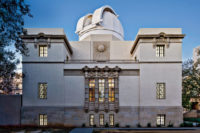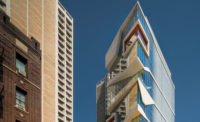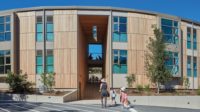Open since October, the Greenpoint Library and Environmental Education Center is more than a repository of information. Designed by Marble Fairbanks, it is a symbol of an ecological effort that dates back more than 40 years. In 1978, one of the largest oil spills recorded in the United States (at least 50 percent greater than that of the Exxon Valdez) was discovered in a tributary of New York’s East River. Between 17 and 30 million gallons of oil and refining products leaked from processing facilities in Greenpoint, Brooklyn, and seeped deep into 55 acres of soil and aquifer in both industrial and residential areas. After years of litigation and slow remediation, this disaster became a catalyst for the new public library, which offers a unique focus on sustainability and the local ecosystem in a building that exemplifies the principles of good stewardship.
Despite the ongoing cleanup, Greenpoint—with its desirable location on the East River, opposite midtown Manhattan—has been gentrifying with new development. Yet it retains much of the multi-ethnic working-class population spawned by a still-active commercial zone. According to firm principal Karen Fairbanks, neighborhood residents, who were frustrated with the existing outdated small, dark library branch from the 1970s, initiated the $23 million project: it was financed with $5 million from the Greenpoint Community Environmental Fund (instituted with money from ExxonMobil for the spill) and $18 million from additional city and state sources.
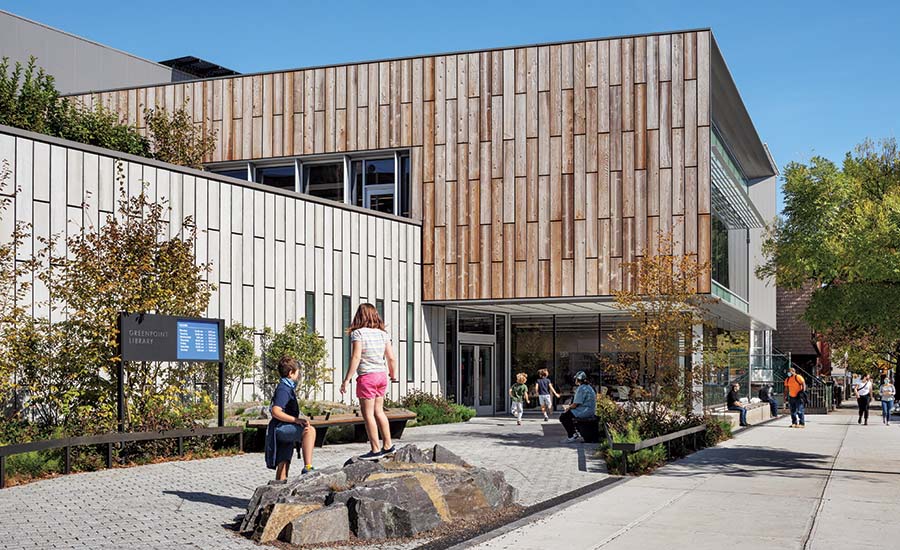
The facade’s contrasting cedar and concrete planks present a lesson in materiality, while the plaza nods to the local ecology with native plantings and granite boulders. Photo © Michael Moran, click to enlarge.
Situated on a prominent corner, the 15,000-square-foot steel-and-concrete structure immediately grabs your attention with a gracious plaza. Marble Fairbanks wanted to introduce public green space where there had been none and so massed the building by stacking a pair of orthogonal volumes and rotating them at right angles to establish three tiered outdoor areas: the plaza at grade, a second-level reading garden, and a rooftop horticultural classroom. Broad expanses of deep-set louvered and insulated glass span the southeast and west facades to visually connect passersby with the reading rooms, and to infuse the interior with strategically shaded daylight. The massing also enabled the creation of a welcoming backlit entrance canopy beneath an overhang.
The architects clad the upper volume with sandblasted-cedar panels made in the nearby Brooklyn Navy Yard, then used the same wood as formwork for glass-fiber-reinforced concrete panels on the lower volume. This move, says project architect Jason Roberts, places the more durable material at the street level and contrasts it with the wood, which will age, above. The split levels and bold materiality also minimize the bulk of the structure so that it fits within Greenpoint’s patchwork of old and new buildings faced in wood, brick, and vinyl siding.
Besides collaborating with the client (the Brooklyn Public Library), Fairbanks and her team worked with the community and local environmental groups, as well as landscape architect SCAPE and ads Engineers, to develop the programmatic, material, and sustainability strategies, ultimately targeting LEED-Platinum certification. Products, sourced within 500 miles when possible, include the work of local artisans and fabricators; 87 percent of the wood comes from sustainable forests; and low-VOC adhesives, coatings, and flooring were used throughout. Efficient systems include low-velocity-displacement ventilation; controlled LED lighting; and bidirectional solar panels on the roof, estimated to offset more than 10 percent of the building’s annual energy consumption. These components (and more) are identified and explained on wall plaques.
SCAPE introduced immersive landscapes that connect to the urban and ecological context. In homage to the region’s geological history, bands and outcroppings of granite on the plaza trace the movement of the Laurentide Ice Sheet across Brooklyn 18,000 years ago. Native plantings, bioswale, and permeable pavers manage runoff, with excess rainwater directed into a retention tank below ground. More native plants and fruit-bearing shrubs in the reading garden on the second floor provide food and habitat for birds and insects, and water from a 1,500-gallon cistern is used by student and community groups who pump it by hand to tend raised beds and a green roof on the upper level.
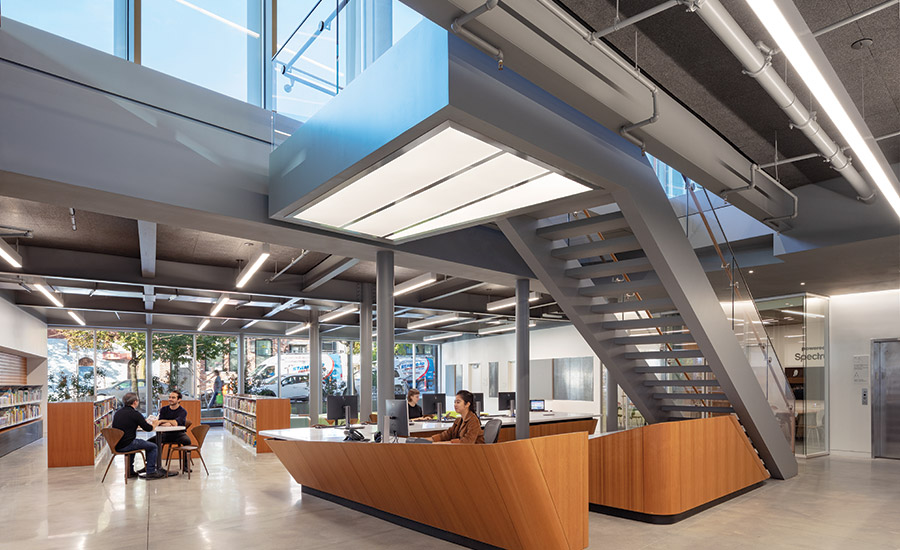
1
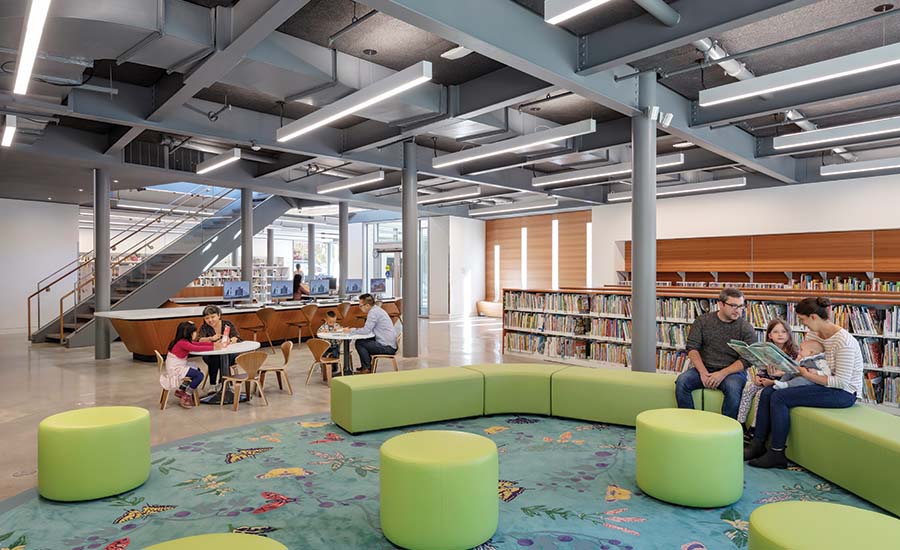
2
The main desk curves into a public computer station (1), flanked by adult and children’s reading rooms (2). Photos © Michael Moran
Walking in from the street, you’ll find adult and children’s reading rooms on either side of a cherry-clad main desk. Such local wood figures prominently throughout the interior, as do select shades of green. Marble Fairbanks seized every opportunity to insert details that reinforce the program: four narrow south-facing windows near the entrance each align to highlight the path of the sun on the concrete floor during an equinox or solstice.
The actual environmental center is one flight up, where a lounge opens to the reading garden. This central space, or “eco lounge,” is bordered by a glazed “teen lab” and 1,400-square-foot community room that can be divided in two for simultaneous educational and social activities. The lounge also features a display wall to showcase projects, art, and other materials that will increase awareness about sustainability. A digital monitor explains the building and presents data such as its energy use and how much the solar panels generate.
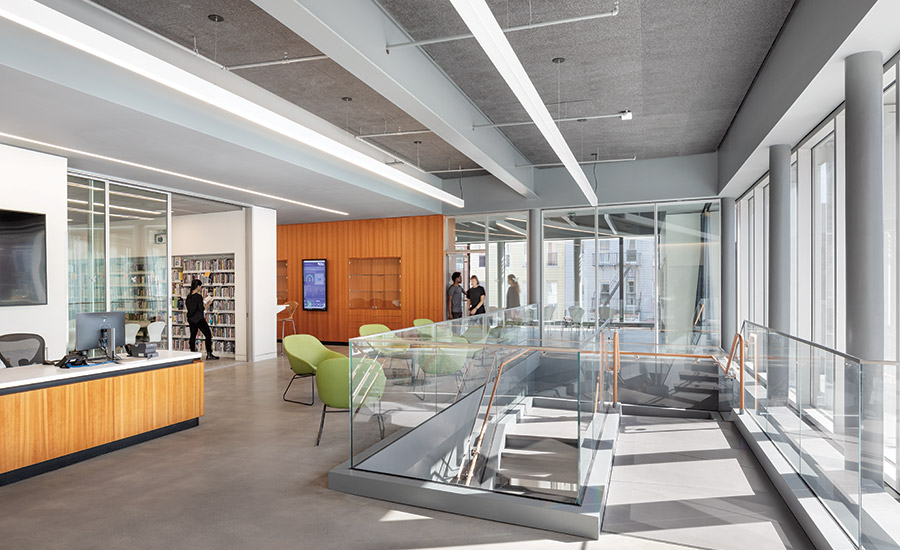
3
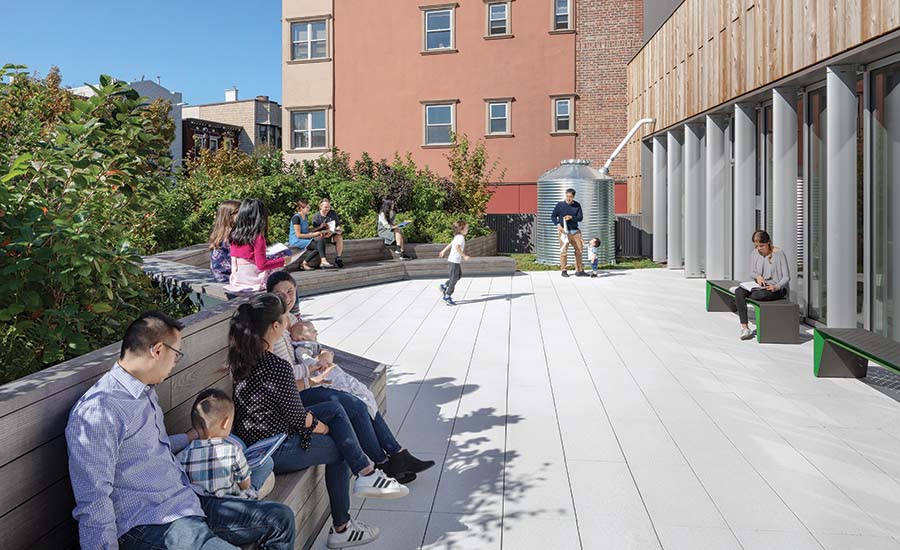
4
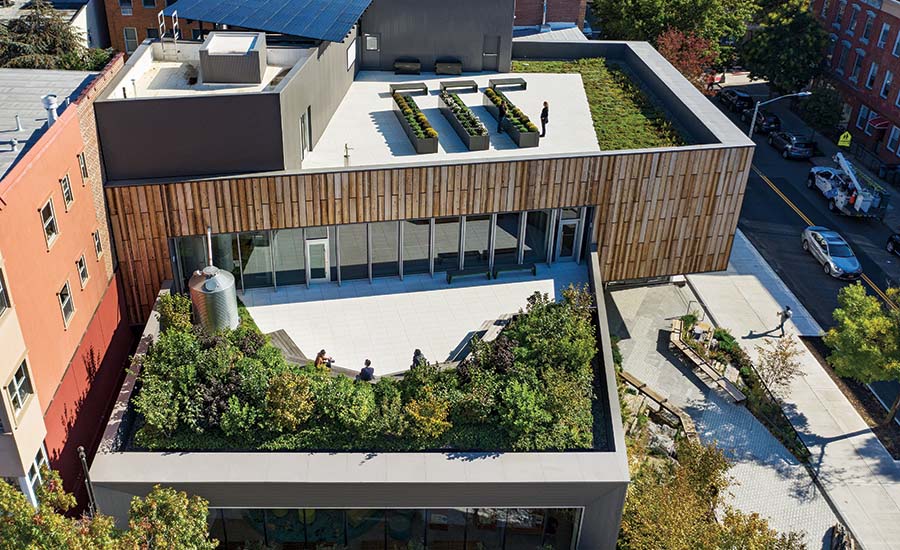
5
A lounge on the second floor (3) opens to the reading garden (4), where a cistern collects water to be retrieved by a hand pump in the demonstration garden above it (5). Photos © Michael Moran
A first of its kind in its dual identity, the Greenpoint Library and Environmental Education Center is poised to be a popular neighborhood—and city—resource. This was apparent on a recent winter afternoon when, even during the limited access due to Covid, parents with kids were lining up to retrieve books at the door. “It’s going to be exciting to see these spaces filled with people, doing all those things you didn’t realize they were going to do,” says Fairbanks.
Click plans to enlarge
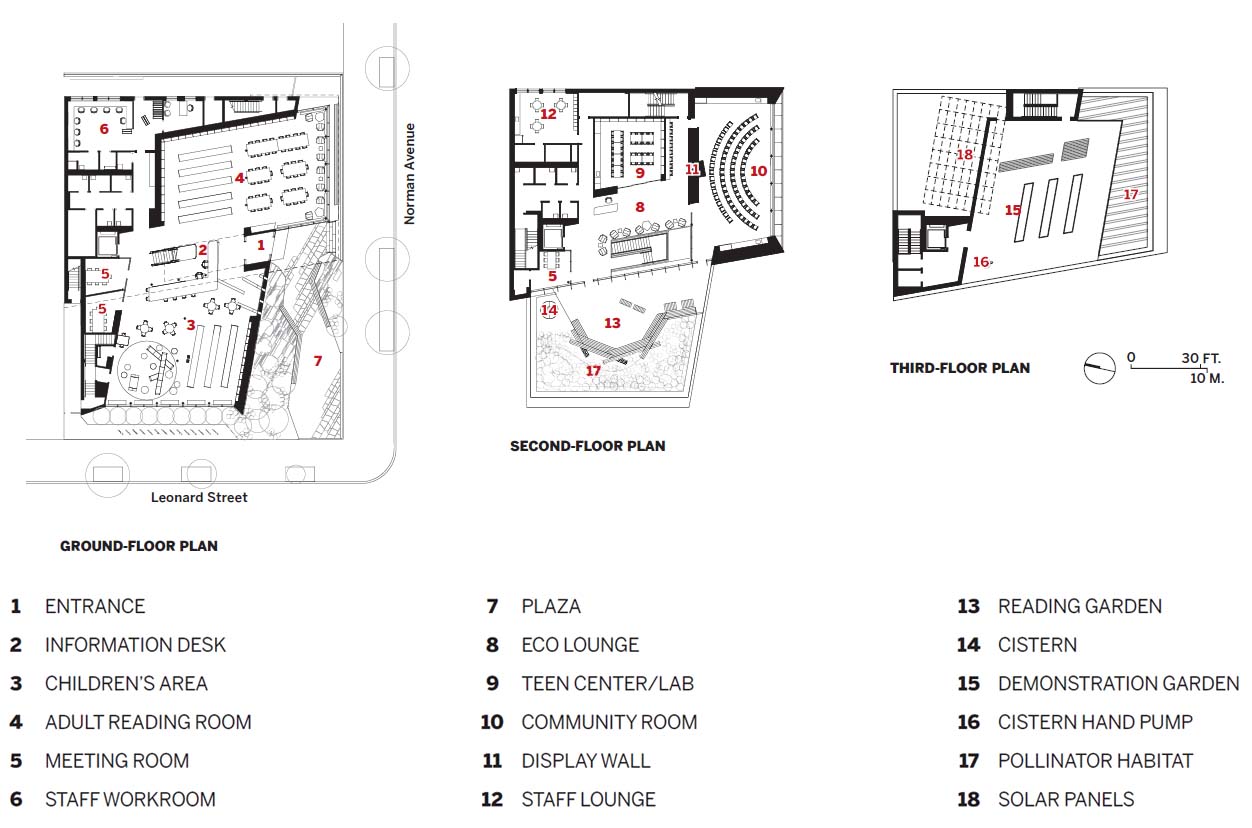
Credits
Architect:
Marble Fairbanks — Karen Fairbanks, Scott Marble, Jason Roberts, Nicholas Desbiens, Peter Adams, Benjamin Hait, Keenan Korth, Lauren Espeseth, Spenser Krut, Tanya Gershon, Ravipa Ramyarupa
Engineers:
Silman (structural); ads Engineers (m/e/p/fp); Yu & Associates (civil/geotechnical)
General Contractor:
Westerman Construction
Consultants:
SCAPE (landscape architect); Tillotson Design Associates (lighting); Jam Consultants (code expeditor); Cosentini Associates (IT/Security); MTWTF (wayfinding)
Client:
Brooklyn Public Library
Size:
15,000 square feet
Cost:
$23 million
Completion Date:
October 2020
Sources
Cladding:
Morin; Pac-Clad; 3M; Evan Eisman (cedar panels); Concreteworks East (GFRC panels)
Curtain Wall:
Kawneer
Glazing:
Oldcastle BuildingEnvelope
Doors:
Solar Innovations; Assa Abloy
Pavers:
Champlain Stone; Tectura
Stair:
Jaroff Design
Interior Surfaces:
Armstrong; Benjamin Moore; Decoustics; Kydex; Formica; Corian; Avonite; 3Form
Furniture:
Vitra; Cherner; Artifort; Herman Miller; Knoll; Keilhauer; ERG; Hightower; Blondie’s Treehouse
Rug:
Mary Mattingly (design); Classic Rug Collection (realization)
Lighting:
USAI; Acuity; Lucifer; Backlight; Zaneen; Hevi Lite: Acclaim
PV System:
Brooklyn SolarWorks
Energy Management:
Distech



